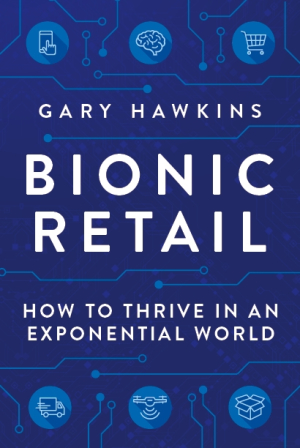Bionic Retail
How to Thrive in an Exponential World
With the knowledge that retail has changed and that supermarkets have lost market shares to wholesalers and restaurants, this forward-thinking business book encourages the informed adoption of new technologies.
Written for those in the grocery sector and drawing on extensive personal experience, Gary Hawkins’s forward-looking business book Bionic Retail is about embracing technology that augurs rapid industry change.
This book catalogs new and emerging technologies with the potential to reshape the grocery sector, including biometric payments, computer vision, artificial intelligence, and retail media networks. It outlines what retailers can expect when adopting these technologies, including internal resistance and skepticism: “The most significant hurdle to pursuing the vision [is] people.” And despite evangelizing for a technology-forward mindset as innovation accelerates and preaching against aversion to change, the book also tempers its tone by warning its audience of potential perils: “Just like in the human body, transplanted ideas and approaches are at risk of rejection by your business if they are not introduced correctly.”
This book is divided into four sections based on broad themes, including inflection points and retail in an exponential context. Its chapters zoom in further, focused on subjects like the speeding up of technological gestation and implementation strategies. In addition to insider details about retailers’ operations, the book includes case studies illustrating how various companies tackled challenges, alongside warning-filled examples of how nongrocery retailers including Kodak, Blockbuster, and certain record labels failed to recognize the disruptive threats posed by new technologies. More directly applicable is its commentary on Kroger buying out its rival, Albertsons.
When it’s incorporating big ideas like chaos theory to explain how disruption can be unpredictable, the text becomes too diffuse; it also notes that military planners relied on meteorologists during World War II but couldn’t account for unforeseen weather while plotting D-Day—an interesting but far-afield example. Its industry-specific data is more clarifying, with information on how the number of marketing technology firms skyrocketed between 2011 and 2022 and on Kroger’s targeted marketing approach. Industry jargon sometimes works against its delivery, though, including the incorporation of buzzwords. It is more effective at distilling information about new technologies, including big data and digitalization, down to its essence for general audiences, getting its points across in sometimes dramatic fashion: “This isn’t some far-off technology or scene from a science-fiction movie. This technology is here. Now.”
With the grocery retail industry in mind, the business book Bionic Retail muses on forthcoming technological changes and encourages the early adoption of new approaches.
Reviewed by
Joseph S. Pete
Disclosure: This article is not an endorsement, but a review. The publisher of this book provided free copies of the book and paid a small fee to have their book reviewed by a professional reviewer. Foreword Reviews and Clarion Reviews make no guarantee that the publisher will receive a positive review. Foreword Magazine, Inc. is disclosing this in accordance with the Federal Trade Commission’s 16 CFR, Part 255.

